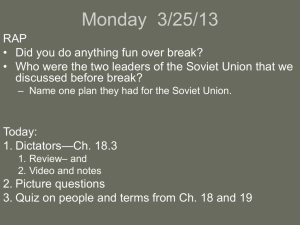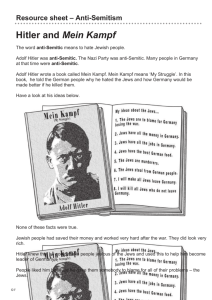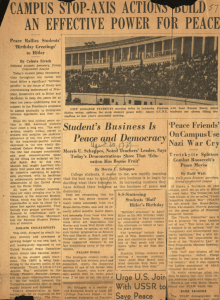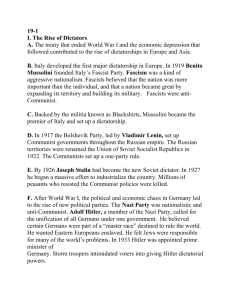Isolation to World War
advertisement
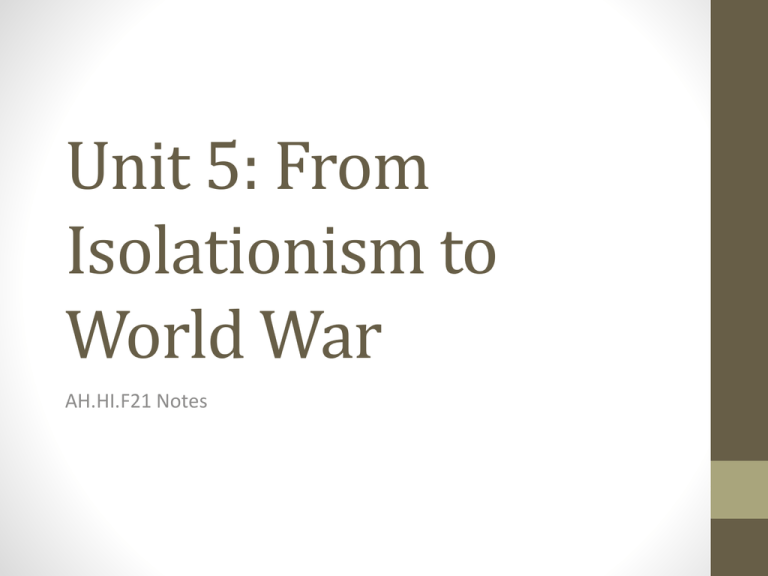
Unit 5: From Isolationism to World War AH.HI.F21 Notes Content Statement 21 • During the 1930s, the U.S. government attempted to distance the country from earlier interventionist policies in the Western Hemisphere as well as retain an isolationist approach to events in Europe and Asia until the beginning of WWII. Intervention in Latin America • Monroe Doctrine – stated any colonization in North America would be viewed as a threat requiring U.S. intervention • Roosevelt Corollary – reserved the right of the United States to interfere in Latin America • Both passed by Theodore Roosevelt challenging American isolationist practices • Attempted to keep Latin America free of European influences • Good Neighbor Policy – passed by Franklin Roosevelt forbidding intervention in Latin American affairs forcing a return to isolationism in 1930 Neutrality Acts • Attempts to isolate the U.S. from the problems erupting in Asia and Europe • Created weapons embargos with other countries who were at war or involved in a civil war (Spain) • Limited loans Failures of Treaty of Versailles • Germany saw nothing fair in accepting all blame for WWI, losing all overseas colonies, and border territories • Soviets lost territory as well • Worldwide depression and economic struggle • Countries began to turn to authoritarian leaders to solve economic and social problems Joseph Stalin – “Man of Steel” • Ioseb Besarionis dze Jughashvili • Made agricultural and industrial growth primary goals • Abolished all privately owned farms and replaced them with collectives (govt. owned farms worked by families) • All economic activity was placed under govt. control • Eliminated anyone who was a threat to his power Joseph Stalin – “Man of Steel” • Historians estimate he was responsible for the deaths of 8 to 13 million people • Many people died from famine as well • Totalitarian government – individuals have no rights and all opposition is suppressed Famine in the Ukraine Famine in the Ukraine Gulags Gulag Benito Mussolini – “Il Duce” • Established totalitarian regime in Italy • Was a powerful public speaker • Mussolini and followers (Black Shirts) marched to Rome demanding power Black Shirts Fascist/Nazi Salute Benito Mussolini • “Italy wants peace, work, and calm. I will give these things with love if possible, with force if necessary.” Benito Mussolini Fascism • Stressed extreme nationalism • Placed the interest of the state above those of individuals • Power should rest with one strong leader and a small group of devoted party members • Favored military expansion • Extreme censorship throughout country Adolf Hitler – “Der Fuhrer” • A former soldier of WWI • Joined the National Socialist German Worker’s Party (Nazis) and quickly became leader • Powerful public speaker who promised to bring Germany out of chaos • Appointed Chancellor of Germany in 1933 and established Third Reich Mein Kampf – “My Struggle” • Book written by Hitler which became the plan of action for Nazi Party • Displayed extreme anti-Semitism (hatred of Jews) • Spoke of racial purification – Aryan (blonde hair/blue eyes) was superior race • Jews, Slavs and other non-white races were inferior Mein Kampf – “My Struggle” • ...the personification of the devil as the symbol of all evil assumes the living shape of the Jew. -Adolf Hitler (Mein Kampf) • “The application of force alone, without moral support based on a spiritual concept, can never bring about the destruction of an idea or arrest the propagation of it, unless one is ready and able ruthlessly to exterminate the last upholders of that idea even to a man, and also wipe out any tradition which it may tend to leave behind.” Adolf Hitler (Mein Kampf) Nazi Propaganda Appeasement • Hitler believed Germany needed more living space • Many countries viewed this as a serious threat but wanted to remain isolationist • Appeasement – giving in to demands to satisfy an aggressor • Munich Conference-France and UK allowed Germany to take Czechoslovakia without conflict, as long as Hitler agreed not to take any more land Aid to Allies • Cash and carry policy – replaced neutrality acts allowing the sale of war goods providing other countries organized transportation and paid in cash • Destroyer-for Bases Agreement –Roosevelt's compromise for helping Britain as he could not sell Britain US destroyers without defying the Neutrality Act; Britain received 50 old but still serviceable US destroyers in exchange for giving the US the right to build military bases on British Islands in the Caribbean. • Lend-Lease Policy – U.S. shipped $50 billion in supplies to “the government of any country whose defense the President deems vital to the defense of the United States.” • Atlantic Charter – stated the overall goals of the war for the Allies in defeating the Nazis Pearl Harbor (December 7, 1941) • 180 planes launched from six aircraft carriers. • By 9:30 the last Japanese planes soared off after continuously attacking Pearl Harbor for a hour and a half. • 1,178 wounded • 2,403 Americans were killed • 21 ships sank or damaged • Survival of three aircraft carriers prove crucial to the war’s outcome • “A date that will live in infamy” US DECLARES WAR! • December 8, 1941US declares war on Japan • December 11, 1941US declares war on Germany
